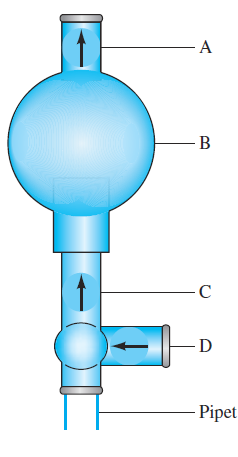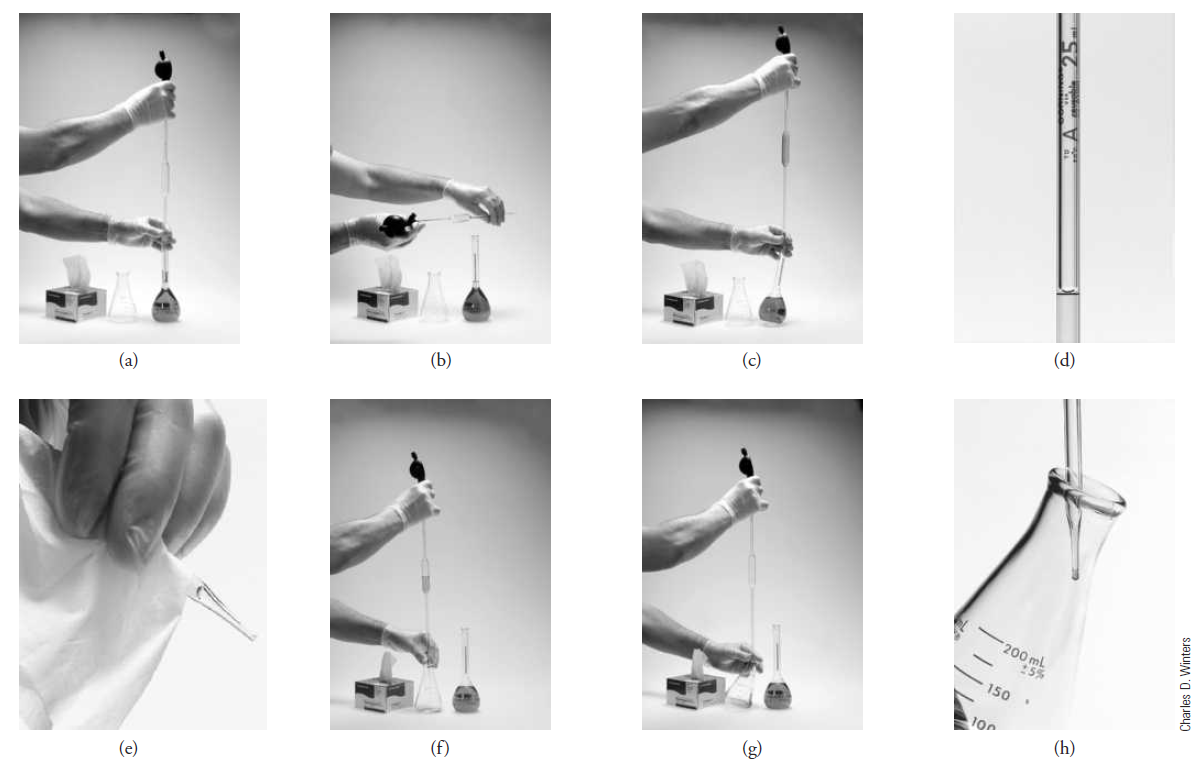


 علم الكيمياء
علم الكيمياء 
 الكيمياء التحليلية
الكيمياء التحليلية 
 الكيمياء الحياتية
الكيمياء الحياتية 
 الكيمياء العضوية
الكيمياء العضوية 
 الكيمياء الفيزيائية
الكيمياء الفيزيائية
 الكيمياء اللاعضوية
الكيمياء اللاعضوية 
 مواضيع اخرى في الكيمياء
مواضيع اخرى في الكيمياء
 الكيمياء الصناعية
الكيمياء الصناعية |
Read More
Date: 20-4-2017
Date: 4-3-2018
Date: 25-4-2017
|
Directions for Using a Pipet
The following directions are appropriate specifically for volumetric pipets but can be modified for the use of other types as well. Liquid is drawn into a pipet through the application of a slight vacuum. Never pipet by mouth because there is risk of accidentally ingesting the liquid being pipetted. Instead, use a rubber suction bulb (such as the one shown at the top of the next page) or one of a number of similar, commercially available devices. Many devices are commercially available for filling pipets and dispensing liquids from them. The device shown here is offered by many suppliers and manufacturers. Originally called the Propipette, it is a very handy device for the task. It consists of a rubber bulb (B) attached to three short sections of tubing.

Each section of tubing contains a small chemically inert ball (A, C, and D) that functions as a valve to permit air to flow normally in the directions indicated by the arrows. The valves are opened by pinching with your thumb and forefinger. The bottom of the device fits snugly on the top of a pipet. Operation begins by opening valve A and squeezing bulb B to expel the air in the bulb. Valve A is then closed, and valve C is opened to draw liquid into the pipet to the desired level, after which C is closed. The liquid level is then adjusted in the pipet by carefully opening valve D, and finally, the liquid in the pipet is delivered by opening valve D completely.
Cleaning
Draw detergent solution to a level 2 to 3 cm above the calibration mark of the pipet. Drain this solution and then rinse the pipet with several portions of tap water. Inspect for film breaks, and repeat this portion of the cleaning cycle if necessary. Finally, fill the pipet with distilled water to perhaps one third of its capacity and carefully rotate it so that the entire interior surface is wetted. Repeat this rinsing step at least twice.
Measuring an Aliquot
Draw a small volume of the liquid to be sampled into the pipet (see Figure 1 a) and thoroughly wet the entire interior surface (Figure 1 b). Repeat with at least two additional portions. Then carefully fill the pipet to a level somewhat above the graduation mark. Be sure that there are no bubbles in the bulk of the liquid or foam at the surface. Touch the tip of the pipet to the wall of a glass vessel as shown in Figure 1 c (not the container into which the aliquot is to be transferred), and slowly allow the liquid level to drop. As the bottom of the meniscus coincides exactly with the graduation mark (Figure 1 d), stop the flow. Remove the pipet from the volumetric
flask, tilt it until liquid is drawn slightly up into the pipet, and wipe the tip with a lintless tissue as shown in Figure 1 e. Then place the pipet tip well within the receiving vessel, and allow the liquid to drain (Figure 1 f ). When free flow ceases, rest the tip against the inner wall of the receiver for a full 10 seconds (Figure 1 g, h).
Finally, withdraw the pipet with a rotating motion to remove any liquid adhering to the tip. The small volume remaining inside the tip of a volumetric pipet should not be blown or rinsed into the receiving vessel. Rinse the pipet thoroughly after use.

Figure 2-22 Dispensing an aliquot. (a) Draw a small amount of the liquid into the pipet and (b) wet the interior surface of the glass by tilting and rotating the pipet. Repeat this procedure two more times. Then draw liquid into the pipet so that the level is a few centimeters above the line etched on the stem of the pipet. While holding the tip of the pipet against the inside surface of the volumetric flask (c), allow the liquid level to descend until the bottom of the meniscus is aligned with the line (d). Remove the pipet from the volumetric flask, tilt it (e) until liquid is drawn slightly up into the pipet, and wipe the tip with a lintless tissue as shown. Then while holding the pipet vertically, (f ) allow the liquid to flow into the receiving flask until just a small amount of liquid remains in the inside of the tip and a drop remains on the outside. Tilt the flask slightly as shown in (g), and finally, touch the tip of the pipet to the inside of the flask (h). When this step is completed, a small amount of liquid will remain in the pipet. Do not remove this remaining liquid. The pipet is calibrated to reproducibly deliver its rated volume when this liquid remains in the tip.



|
|
|
|
تفوقت في الاختبار على الجميع.. فاكهة "خارقة" في عالم التغذية
|
|
|
|
|
|
|
أمين عام أوبك: النفط الخام والغاز الطبيعي "هبة من الله"
|
|
|
|
|
|
|
قسم شؤون المعارف ينظم دورة عن آليات عمل الفهارس الفنية للموسوعات والكتب لملاكاته
|
|
|